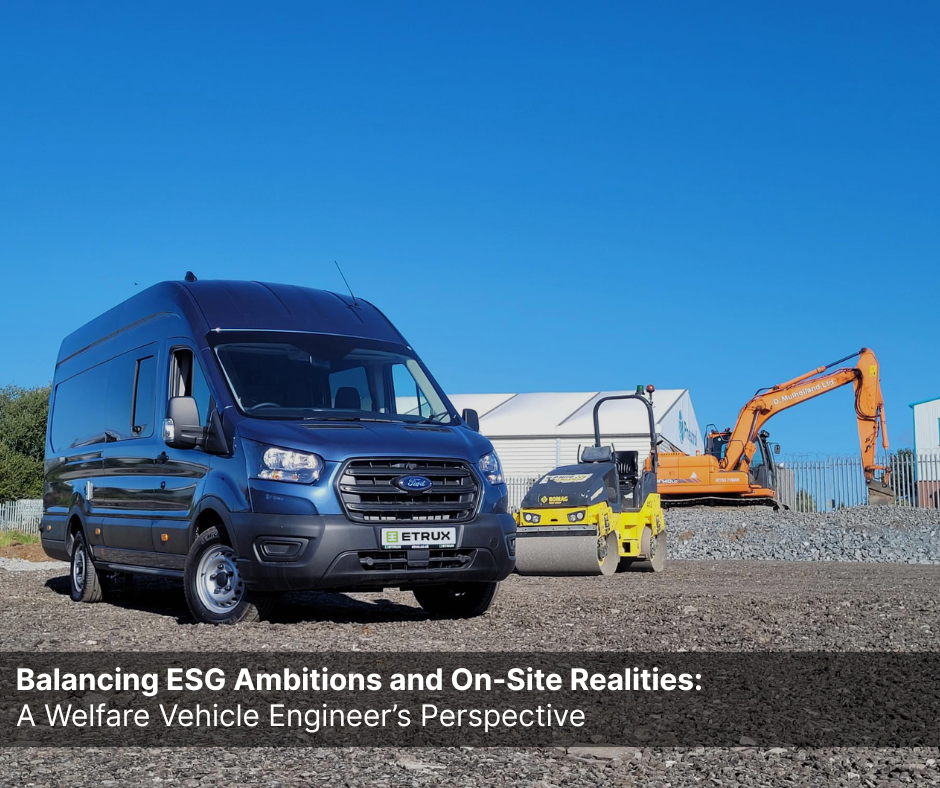In the construction world, the gap between ambition and practicality has never felt wider. On one hand, ESG targets are no longer just a box-ticking exercise — they’re central to how contractors win work, retain talent, and futureproof operations. On the other, the day-to-day realities of running a fleet and managing sites are more complex than ever. Costs are under scrutiny, margins are tight, and expectations from clients and regulators continue to rise.
As an engineer deeply involved in designing welfare vehicle conversions for major construction firms, I spend a lot of time with decision-makers — from CFOs to Heads of Fleet — who are stuck navigating this exact tension. They want to do the right thing, both for the planet and their people, but they also need vehicles that are dependable, cost-justified, and aligned with wider commercial goals.
Here’s what I’ve learned, and why I believe the right welfare vehicle strategy can quietly unlock big ESG wins — without burdening the business.
The Hidden ESG Power of a Smartly Spec’d Welfare Vehicle
When people talk about ESG in construction, it’s often in terms of carbon targets, supply chain accountability, and reporting obligations. But dig a little deeper, and welfare vehicles sit right at the intersection of environmental, social, and governance performance — even if they don’t always get the headlines.
- Environmentally, there’s the obvious transition to BEV platforms and the opportunity to reduce tailpipe emissions, particularly on inner-city or low-emission sites. But there’s also the chance to incorporate more efficient power systems, reduce idling, and spec lighter, longer-lasting materials.
- Socially, these vehicles are frontline tools for supporting workforce wellbeing. The
conditions inside a welfare unit affect morale, safety, productivity — even staff retention. If you’re asking teams to work in challenging environments, the quality of that space speaks volumes about your values as a business. - And from a governance angle, compliant, professionally converted welfare vehicles help reduce risk — whether that’s legal liability, site inspection failure, or reputational damage from cutting corners.
What we’re really talking about here is outcomes. Not just what’s inside the vehicle, but what that vehicle enables: safer sites, happier crews, reduced downtime, better sustainability reporting, and ultimately, fewer operational headaches.
Buyers Are Under Pressure — And We Get It
The problem? These outcomes often get buried under a pile of spec sheets and sales pitches that don’t speak the buyer’s language.
If you’re a Head of Fleet or CFO, your concerns probably sound more like this:
- “How do I justify the spend when budgets are already stretched?”
- “Can I trust this conversion won’t cause warranty issues or unexpected downtime?”
- “Is this vehicle futureproof — or will I be reworking it in six months to meet new
requirements?”
These are legitimate questions. And frankly, they’re the same questions we ask ourselves during the design process.
The truth is, welfare vehicle conversions shouldn’t be treated as a one-size-fits-all solution or a short-term fix. They’re strategic assets. And when you approach them with the right level of engineering intelligence and business understanding, they deliver value far beyond the purchase order.
That’s the approach we take: start with the outcomes, design for the realities, and build with integrity.
Why Ford Pro Convertor Status Matters
In a crowded market, it can be hard to tell one converter from another. But there’s a reason why our Ford Pro Convertor status matters — and why it should matter to buyers too.
To achieve this recognition, we’ve met Ford’s highest standards in engineering quality, compliance, integration, and aftersales support. We work closely with Ford’s technical teams to ensure every conversion aligns with their safety systems, warranty expectations and software configurations. This matters even more in the world of BEV, where integration between platform and conversion is critical for long-term performance.
What does this mean for you?
- Reduced risk – Your warranty stays intact. No surprises.
- Reliable support – We work in sync with Ford’s service network.
- Future readiness – Our conversions align with Ford’s latest models, including electric
platforms. - Procurement confidence – You’re buying from a trusted, approved source.
In other words, you’re not just buying a vehicle — you’re buying certainty, at a time when every operational decision carries more weight than ever.
Welfare, ESG, and the Big Picture
In our experience, the best welfare conversions don’t shout about features — they quietly deliver results. They help reduce scope 1 emissions. They support mental health on site. They meet client requirements and demonstrate that your business walks the talk on ESG.
But none of that happens by accident.
It takes intelligent design, hands-on understanding of construction challenges, and a genuine commitment to quality. It also takes a supplier who’s willing to have commercial conversations, not just technical ones — someone who understands the pressure you’re under to deliver value, not just vehicles.
That’s who we aim to be. And that’s why we believe welfare vehicles, when done right, are one of the smartest investments you can make in your ESG strategy.
If you’re planning your next fleet upgrade, we’d love to show you what that looks like in practice.

